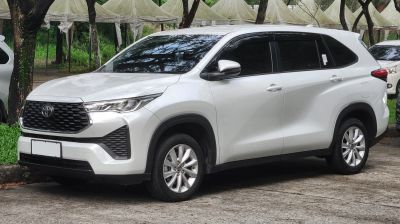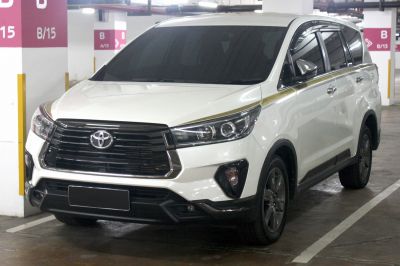 2015 Toyota Kijang Innova II Dimensions, Size & Specs
2015 Toyota Kijang Innova II Dimensions, Size & SpecsMeasurements of the 2015 Toyota Kijang Innova II, engineered for optimal performance and comfort
| Dimensions | |
|---|---|
| Length: | 4735 mm186.4 in15.5 ft |
| Width: | 1830 mm72.0 in6.0 ft |
| Height: | 1795 mm70.7 in5.9 ft |
| Weight Specifications | |
| Curb Weight: | 1720-1820 kg3792-4012 lbs |
| Maximal permitted Weight: | 2340-2450 kg5159-5401 lbs |
| Tire Specifications | |
| Rims Sizes: |
|
| Tire Sizes: |
|
The Toyota Innova Kijang Innova II, produced between 2015 and 2020, is a versatile minivan designed to offer ample space and comfort for families and group travel. This second-generation Innova features a length of 4735 mm (186.4 inches), a width of 1830 mm (72 inches), and a height of 1795 mm (70.7 inches), making it a roomy vehicle that balances interior space with manageable exterior dimensions for urban and highway driving. The curb weight ranges from 1720 to 1820 kg (3794 to 4012 lbs), while the maximum weight capacity spans from 2340 to 2450 kg (5159 to 5399 lbs), reflecting its sturdy build suitable for carrying multiple occupants and cargo safely. It comes equipped with rim size options of 16 inches and 17 inches, paired with tire sizes of 205/65 R16 and 215/55 R17, respectively, to provide flexibility suited to various driving conditions. The Kijang Innova II maintains Toyota’s hallmark of reliability and efficiency, combining practical dimensions and robust engineering, making it an excellent option in the minivan segment for those seeking spaciousness without compromising maneuverability.
Discover the standout features that make the 2015 Toyota Kijang Innova II a leader in its class
Have a question? Please check our knowledgebase first.
The Toyota Innova Kijang Innova II, produced from 2015 to 2020, measures 4735 mm (186.4 inches) in length, 1830 mm (72.0 inches) in width, and 1795 mm (70.7 inches) in height. These dimensions place it squarely in the minivan category, offering a spacious interior while still being manageable for urban driving. The length provides ample cabin space for passengers and cargo, whereas the width assures comfortable seating arrangements across three rows. The height offers good headroom and a commanding view of the road. These dimensions strike a balance between interior comfort and vehicle maneuverability.
The curb weight of the Toyota Innova Kijang Innova II ranges from 1720 kg to 1820 kg (approximately 3794 to 4012 lbs), depending on the variant and equipment levels. This weight reflects the fully equipped vehicle ready to drive without passengers or cargo. The maximum permissible weight ranges from 2340 kg to 2450 kg (about 5161 to 5401 lbs), which accounts for passengers, luggage, and fuel. This payload capacity is quite substantial for a minivan, allowing for comfortable transportation of multiple passengers and cargo without compromising vehicle safety or performance.
A standard household garage typically measures around 2.4 to 2.7 meters (7.9 to 8.9 feet) in width and about 5.0 to 6.0 meters (16.4 to 19.7 feet) in depth. Considering the Innova Kijang Innova II's dimensions—4735 mm (4.735 meters or 15.52 feet) in length and 1830 mm (1.83 meters or 6.0 feet) in width—the vehicle can generally fit into a standard garage lengthwise with some clearance to spare. Width-wise, the Innova's 1.83 m fits comfortably within typical garage widths, though space may be a bit tighter depending on garage size and additional items stored inside. Its height of 1.795 m (5.89 feet) is well within garage door height limits. Overall, parking the Innova Kijang Innova II in a standard garage is feasible but might require careful maneuvering.
Compared to the predecessor, the first-generation Toyota Kijang Innova, which was produced until 2015, the Kijang Innova II (2015-2020) generally offers a larger and more modern footprint. The first generation measured approximately 4585 mm (180.5 inches) in length, 1775 mm (69.9 inches) in width, and 1795 mm (70.7 inches) in height. In contrast, the second-generation Kijang Innova II is 4735 mm (186.4 inches) long and 1830 mm (72.0 inches) wide, representing an increase of about 150 mm in length and 55 mm in width, while height remains consistent. This increase allows for improved interior space, passenger comfort, and a more spacious cargo area, reflecting Toyota's response to market demands for larger, more comfortable minivans.
The Toyota Innova Kijang Innova II's width of 1830 mm (72.0 inches) contributes significantly to its road stability and interior spaciousness. A wider track provides better lateral grip and balance during cornering and reduces body roll, enhancing driver confidence and passenger comfort. Meanwhile, the height of 1795 mm (70.7 inches) allows for an elevated seating position, which improves visibility and makes ingress and egress easier. However, the taller height can increase aerodynamic drag and susceptibility to crosswinds compared to lower-profile vehicles. Toyota's chassis design and suspension tuning compensate for these factors, ensuring a well-balanced driving experience typical for a minivan.
The Kijang Innova II comes equipped with 16-inch and 17-inch rim options depending on the trim level. These are paired with tire sizes of 205/65 R16 and 215/55 R17 respectively. The 16-inch rims with taller 205/65 tires provide a softer ride due to the higher tire sidewall, which absorbs road imperfections better. In contrast, the 17-inch rims with lower-profile 215/55 tires offer crisper handling and better road grip due to reduced sidewall flex but may result in a firmer ride. Both tire sizes maintain a balanced mix of comfort, handling, and fuel efficiency, tailored to different customer preferences and driving conditions.
When compared to competitors like the Honda Mobilio or Nissan Serena in the same segment, the Toyota Innova Kijang Innova II stands out with its larger dimensions. For instance, the Honda Mobilio typically measures around 4395 mm (173 inches) in length, making the Innova approximately 340 mm (13.4 inches) longer, offering more interior space and cargo capacity. The Nissan Serena, a larger competitor, is close in size with a length of around 4695 mm (184.8 inches), slightly shorter than the Innova. Width-wise, the Innova's 1830 mm (72 inches) is wider than many rivals, enhancing cabin room and stability. These dimensional advantages make the Innova particularly attractive to buyers needing considerable passenger and cargo space.
The Toyota Innova Kijang Innova II is designed as a versatile minivan with a focus on practicality and comfort. It typically offers seating for seven to eight passengers arranged in three rows, depending on the variant and market. The spacious interior benefits from the car's generous length and width, providing ample legroom and headroom for passengers even in the third row, which is often cramped in smaller minivans. The flexible seat configurations enable easy folding or removal of seats to increase cargo space, catering to both family usage and commercial needs. Interior ergonomics and storage solutions also emphasize user convenience and comfort.
With a length of 4735 mm (186.4 inches) and width of 1830 mm (72.0 inches), the Kijang Innova II is larger than compact minivans but smaller than full-size vans. This size strikes a balance, allowing relatively easy maneuverability in urban and suburban environments while offering spaciousness for passengers and cargo. The vehicle's turning radius is optimized to accommodate city driving, parking, and tight spaces, although it requires more attention compared to smaller cars. Toyota’s suspension and steering systems are tuned to offer stable handling and responsive control, making the Innova manageable despite its substantial dimensions.
Across the 2015-2020 production run, the Toyota Innova Kijang Innova II's curb weight ranges from approximately 1720 kg to 1820 kg (3794 to 4012 lbs), influenced by factors such as trim level, drivetrain configuration, added equipment, and safety features. The maximum permissible weight, accounting for passengers and cargo, varies between 2340 kg and 2450 kg (5161 to 5401 lbs). Variability in weight is typical among trims due to optional features like alloy wheels, infotainment systems, and engine types. These figures are crucial for ensuring compliance with load limits and for drivers to understand payload capabilities to maintain safe and efficient vehicle operation.
Discover similar sized cars.

| Production: | 2022-present |
|---|---|
| Model Year: | 2023 |
| Length: | 4755 mm187.2 in |
| Width: | 1850 mm72.8 in |
| Height: | 1795 mm70.7 in |

| Production: | 2020-2022 |
|---|---|
| Model Year: | 2020 |
| Length: | 4735 mm186.4 in |
| Width: | 1830 mm72.0 in |
| Height: | 1795 mm70.7 in |

| Production: | 2020-present |
|---|---|
| Model Year: | 2020 |
| Length: | 4753 mm187.1 in |
| Width: | 1848 mm72.8 in |
| Height: | 1810 mm71.3 in |

| Production: | 2020-present |
|---|---|
| Model Year: | 2020 |
| Length: | 4753 mm187.1 in |
| Width: | 2107 mm83.0 in |
| Height: | 1812 mm71.3 in |
